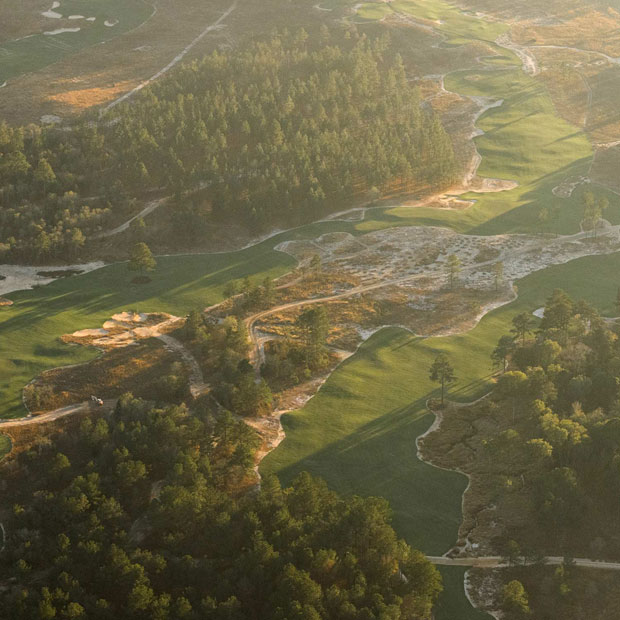Re-Dyeing Kiawah Island
How the Ocean Course has evolved, and why it should evolve back


“Pete always says this golf course walks,” Brain Gerard, Director of Golf at Kiawah Island Golf Resort, told Amy Rogers of PGAChampionship.com. Gerard was remembering how the late Pete Dye talked about the Ocean Course, this week’s PGA Championship venue. “It swims,” Gerard said. “It moves because of the winds and where it’s sitting.”
Indeed, the Kiawah Island property is sandy, marshy, windy, and highly volatile. Hurricane Hugo reshuffled the terrain in September 1989, three months after Dye started building the course. In recent years, sections of the beach have gradually “walked” out to sea.
{{content-block-ocean-course-kiawah-island-pete-dye-evolution-restoration-001}}
But the most significant changes to Dye’s 1991 design haven’t been natural. They’ve been planned and executed by the resort. And while these alterations have not ruined the still-outstanding Ocean Course, they have made it less dynamic and more conventional.
◊
“There was definitely a call to try and make the golf course a little bit more playable for John Q. Public,” said Charleston-based golf architect Troy Miller in an interview I did with him for our recent Ocean Course video. “As hard as the resort has tried, pace of play is always going to be an issue.”
So about a decade into the course’s life, the resort decided to add turf. Dye was involved in this project, as were workers from Landmark Golf, including a young Troy Miller. “When we started to do some of these renovations to try to create more playability,” Miller said, “the idea was always to maintain the visual and provide a little bit more space for play. And what that did was—I would probably say that there is almost 50% more turf on that golf course today than there was in 1991.”
This is not to say that the fairways got wider. In fact, there is less short grass on the Ocean Course now than there was originally. What the resort added in the early 2000s was mostly maintained rough. As aerial views of Nos. 1, 6, 11, and 18 from 1994 and 2018 show, the fairways have become narrower even as the total turf area has expanded.
{{content-block-ocean-course-kiawah-island-pete-dye-evolution-restoration-002}}{{content-block-ocean-course-kiawah-island-pete-dye-evolution-restoration-003}}{{content-block-ocean-course-kiawah-island-pete-dye-evolution-restoration-004}}{{content-block-ocean-course-kiawah-island-pete-dye-evolution-restoration-005}}
While the rough exacts a minor penalty for a missed fairway or green, it also prevents balls from rolling into the marshes and waste areas that border the holes. Spend a day watching the PGA Championship, and you’ll see at least a few errant shots get saved.
Meanwhile, in order to maintain the extra turf and control blowing sand, the Ocean Course has ramped up irrigation. Introducing more water into the ecosystem has made everything lusher, not just the playing surfaces but also the native areas. “And so now,” explained Troy Miller, “instead of having turf that runs off into sand that’s maybe sparsely vegetated with sea oats and some sweet grass, you’ve got a pretty dense edge that’s influenced by the irrigation, so you might have a lost ball on your hands rather than a shot that just goes a little further offline into a sand dune with an opportunity to go hit it and play it again.”
Overall, the Ocean Course has become less wild, less temperamental, and more one-dimensional—a far cry from the Ryder Cup venue that David Feherty described as “like something from Mars.” Today, the well-irrigated fairways and rough tamp down the unpredictability of the ground game. At the same time, if you hit a foul ball, you probably won’t find it, and you won’t be asked to weigh the risks and rewards of a recovery attempt. The consequences of good shots and bad shots alike are more black and white than they used to be.
◊
Yet Kiawah Island Golf Resort’s rationale for these changes is understandable. Most amateurs would find the Ocean Course brutally difficult even if the turf were slow (which it’s not, exactly) and the winds were light (which they almost never are). Somehow the resort needs to get average Joes and Janes around 18 holes in a timely fashion. Plus, the greenkeepers have legitimate concerns about blowing, shifting sand. It’s fun to imagine allowing a golf course to mutate with the elements, but actually doing so can result in a maintenance nightmare.
For Troy Miller, though, both of these problems are less dire than they seem. If the Ocean Course were less irrigated, it would be more fiery, but the native areas would also be more playable. “The golf course [could] regain its roots as a fast, firm test,” Miller said, “with this ability for balls that are hit offline to continue offline into a playable but undesirable location that creates increasingly poor angles into these great greens.”
Yes, more sand might kick up on windy days, and the course might even start “walking” again. But as Miller put it, “I think that’s something where there’s a happy medium. Try and maintain those edges and create a kind of organic blending, but let the golf course move and evolve from season to season and from year to year in a more natural, organic way.” In other words, give some TLC to the boundaries between the playing corridors and the natural vegetation, but don’t worry about fixing them in place.
Listening to Miller, I was struck by his reverence for the original Ocean Course, and I began to wonder why we don’t hear more about restoring Pete Dye’s designs. In the golf course industry today, “restoration” tends to mean turning back the clock to the 1910s, 20s, or 30s. But shouldn’t we be committed to restoring any worthy architecture, no matter its time period? Many of Dye’s projects, from Harbour Town to TPC Sawgrass, would seem to be good candidates for restoration; they have changed profoundly over the years and not always for the better.
Just as there are architects who specialize in recapturing the historical flavor of Seth Raynor and Donald Ross designs, perhaps there should be those who study Pete Dye’s work and try to put his courses back the way they were.
For golf fans who want to bring home a piece of this course, we offer a collection of Kiawah photography prints shot by the Fried Egg Golf team available in our Pro Shop.
Leave a comment or start a discussion
Engage in our content with thousands of other Fried Egg Golf Club Members
Engage in our content with thousands of other Fried Egg Golf Members
Get full access to exclusive benefits from Fried Egg Golf
- Member-only content
- Community discussions forums
- Member-only experiences and early access to events












Leave a comment or start a discussion
Lorem ipsum dolor sit amet, consectetur adipiscing elit. Suspendisse varius enim in eros elementum tristique. Duis cursus, mi quis viverra ornare, eros dolor interdum nulla, ut commodo diam libero vitae erat. Aenean faucibus nibh et justo cursus id rutrum lorem imperdiet. Nunc ut sem vitae risus tristique posuere. uis cursus, mi quis viverra ornare, eros dolor interdum nulla, ut commodo diam libero vitae erat. Aenean faucibus nibh et justo cursus id rutrum lorem imperdiet. Nunc ut sem vitae risus tristique posuere.